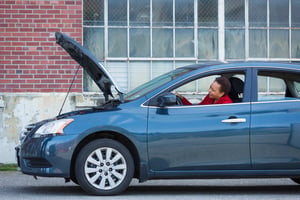 If you’re going, or have gone, on a family road trip, you know there are many things that need to be done to make sure your car is in good working condition before you go. Unfortunately, no matter how much you do or spend, something can still go wrong.
If you’re going, or have gone, on a family road trip, you know there are many things that need to be done to make sure your car is in good working condition before you go. Unfortunately, no matter how much you do or spend, something can still go wrong.
Cars have many different and complex systems that most people don’t think about. These systems keep your car running as efficiently as possible. One of these, the engine cooling system:
- Removes excess heat.
- Maintains the appropriate engine temperature.
- Brings the engine to the appropriate temperature quickly.
If you’ve experienced or saw a car smoking on the side of the road, this means a component of the cooling system failed. Here are some things to keep in mind if this happens to you.
If your engine gets to the point of overheating, significant engine damage can occur. However, before that happens there are usually a few indicators to watch for:
- A white steam that bellows out from under your hood.
- Your engine temperature gauge reaches “H” or moves into the red zone.
- Unusual smells escaping from your engine compartment. Depending on the problem it could smell sweet or burnt.
If you notice any of the indicators above, here some things you should do immediately:
1. Discontinue using your air conditioning (A/C).
If your car is beginning to overheat, it’s a good idea to stop using your A/C immediately. Instead, roll down your windows and set your heat temperature and fan speed to maximum. This technique can help suck heat away from your engine.
2. Safely pull over.
If your car starts smoking, don’t panic. Remain calm and look for a safe place to pull over and turn your car off. As your engine cools, the temperature gauge should return to its normal range.
3. Don’t open your hood.
After you pulled over, it may seem like opening your hood and checking out your engine is the right thing to do. However, it’s best to give your engine some time to cool down. Depending on the outdoor temperature, waiting 15-30 minutes is a good idea. This can help prevent burns or other injuries.
4. Call roadside assistance.
Whether your commute is short or long, purchasing a roadside assistance plan is beneficial. Having it can reduce your stress level if something happens to your car. We’ve used our roadside assistance several times for flat tires. Let’s face it, trying to look at your car on a busy street or freeway can have deadly consequences. It’s best left to the professionals.
5. Stay in your car.
Depending on your location, traffic may be extremely heavy. It’s safest to wait in your car until the police or roadside assistance arrives.
6. Drive your car carefully.
If you don’t have roadside assistance, wait for the engine to cool before driving it to the nearest auto repair center. Be sure to keep an eye on your temperature gauge as you may have to start and stop several times before reaching your destination.
7. Get your car fixed immediately.
If your engine overheats, it’s important to get it to the closest auto repair center. The issue won’t simply resolve itself by letting your engine cool off. There are several reasons for this problem, and it should be diagnosed by a professional mechanic.
Preventative maintenance is a good way to keep your car in top running condition. Refer to your owner’s manual for recommended maintenance schedules.
For information on what your car’s warning lights mean, check out the blog below.
Vehicle warning lights and their meanings [Infographic]
Do you have any tips or information you’d like to share? I’d love to hear them; please share them in the box below.
Source:





